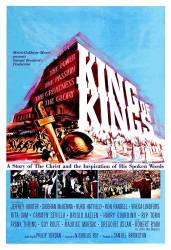Continuity mistake: When Jesus is being flogged, he is turned over onto his back, and whipping is heard. Later on, no marks are to be seen.
Revealing mistake: Have a look at some of the beards (and wigs) in this movie, the facial hair is coming loose on several of the disciples' beards.
Factual error: At the end of the film, Mary Magdalene approaches Jesus just as he has arisen from his tomb, at first shocked that he has arisen. As Jesus is talking to her and motioning with his hands, it is plainly clear that he has no nail marks/stigmata, when he should have. (See John 20: 24-29, where-in the resurrected Jesus shows "Doubting Thomas" the nail prints in his hands.)
Continuity mistake: When the emancipated Barabbas leaves his jail cell, he has a thin beard. Going outside of the prison, Barabbas's beard suddenly appears full and bushy.
Continuity mistake: When Salome is dancing, Herod is drinking wine from a glass cup and then immediately he is holding a a metal cup with no single trace of wine in it.
Continuity mistake: Just before his arrest, Jesus' forehead is laced with sweat. Seconds later it is all gone.
Continuity mistake: Just after Jesus is crowned with thorns,a strange object can be seen on his head. It looks like an urn or vase of some sort. Kind of odd.
Other mistake: The giant medallions that Pilate takes from a chest and then places on the pillar of the Temple do not bear close inspection as images of Tiberius, for some reason the name Augustus is lettered along with abbreviations not easily discerned as what was then used. The image behind Pilate when he is in court is similarly inauthentic but I would think that no-one but an exacting numismatist would even notice this if it is indeed such a major mistake.
Revealing mistake: The final sequence of the film where the Disciples leave a net in different directions is said by the narrator to be the final time Jesus speaks to them. The scene sidesteps all idea of the Ascension of Christ read in the Gospels and there is also no hint of Pentecost. As well as the lack of Christ's wounds on His resurrected body the film has missed important points in the post Resurrection appearances. The figure of Jesus moves awkwardly in shadow in the same mistakenly attributed scene.





